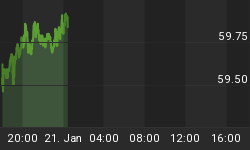
Major market indices (S&P 500, Dow Jones Industrial) are currently closing
On Friday's session, the fact that the VIX (CBOE Volatility Index) closed up big (+6.60%) ahead of a long weekend although major market indices closed almost unchanged (SPY down -0.14%, S&P 500 down -0.16%, and DJ Ind. up +0.12%) got a lot of attention around the blogosphere, regularly referring to the bearish implications of such divergence.
But in order to potentially separate the rumors from the facts, I checked for those occurrences where the SPY (S&P 500 SPDR) did not lose more than -0.25% on close of a session immediately preceding a weekend or an exchange holiday when the VIX either closed up +6.0% (or more), or closed in the top quartile of its daily trading range and up at least +3.0% on the same day (either a huge gain on the close, or at least a long white candle).
Table I below shows all occurrences and the SPY (S&P 500 SPDR)'s historical performance (since 01/01/1990) over the course of the then following 1, 2, 3, 4 and 5 sessions (and the minimum number of sessions - if any - until a higher close was achieved), assumed one went long on close of a session where the setup listed above had been triggered in the past.

(* no close below trigger day's close during period under review)
At least from a historical and statistical point of view, there is nothing bearish about the huge divergence between the VIX and major market indices (quite the opposite). When the setup listed above had been triggered in the past, the SPY (S&P 500 SPDR)
- ... closed higher on the then following session on 14 out of 20 occurrences (or 70% of the time);
- ... lost more than -0.51% on the then following session on only 1 out of those 20 occurrences;
- ... closed at a higher level 2 sessions later on 16 out of those 20 occurrences (or 80% of the time);
- ... closed higher +1.0% or more 2 sessions later on 5, but lower -1.0% or more on only 1 out of those 20 occurrences (or 80% of the time); and
- ... never looked back and did not post a single close below the trigger day's close over the course of the then following 5 sessions on 9 occurrences, but did not post a single close above the trigger day's close on only 3 occurrences.
In addition, the session immediately following the Christmas Day (exchange) holiday shows a significantly positive bias.
Table II below shows all occurrences and the SPY (S&P 500 SPDR)'s historical performance (since 01/01/1990) over the course of the then following 1, 2, 3, 4 and 5 sessions (and the minimum number of sessions - if any - until a higher close was achieved), assumed one went long on close of Christmas Eve (or the session before if Christmas Eve was a non-trading day) in the past.

(* no close below trigger day's close during period under review)
With respect to the session immediately following the Christmas Day (exchange) holiday, the SPY (S&P 500 SPDR)
- ... closed higher on 15 out of the last 20 occurrences (or 75% of the time);
- ... lost more than -0.26% on only 1 out of the last 20 occurrences (2005);
- ... closed at a higher level 2 and 3 sessions later on (almost) 3 out of every 4 occurrences (or 80% of the time); and
- ... closed higher +1.0% or more 2 and 3 sessions later on 7, but lower -1.0% or more on only 2 (3) out of the last 20 occurrences.
Conclusions:
With positive seasonalities and setup(s) triggered on close of Thursday, December 23, from my perspective probabilities and odds are tilt in favor of a higher close on Monday, December 27.
Successful trading,
















